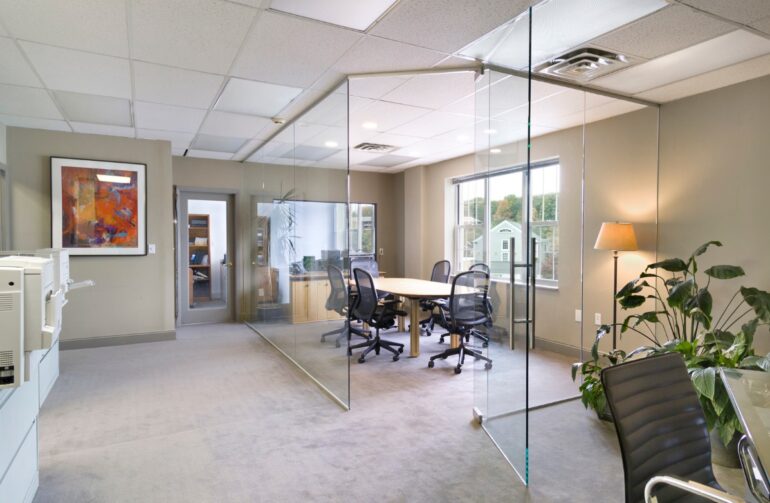Glass conference rooms have emerged as a vital tool in modern office design, serving as a vivid manifestation of the corporate culture of transparency and collaboration. These rooms, often surrounded by clear glass walls, promote a sense of inclusivity, fostering an environment where ideas can flow freely and creativity is encouraged.
They are the hub of teamwork and collaborative synergy, where every team member, regardless of their position or role, can contribute to the collective goal.
The architectural design of glass conference rooms enhances this collaborative synergy. The openness of the space, the natural light that permeates the room, and the visibility of the team’s efforts all contribute to a more vibrant and dynamic work environment.
The glass walls eliminate the physical barriers that can stifle creativity and communication, fostering a more inclusive and collaborative atmosphere.
Moreover, the design of these conference rooms can be tailored to the specific needs and dynamics of the team. They can be outfitted with high-tech tools and amenities, such as interactive whiteboards and video conferencing equipment, to facilitate brainstorming sessions, strategic planning, and project management.
These rooms are not just a physical space, but a strategic tool for fostering collaborative synergy within teams.
Effective Communication: Strategies for Clear and Engaging Meetings in Glass Rooms

Communication is the lifeblood of any organization, and glass conference rooms serve as the epicenter of this vital process. They are designed to facilitate clear, engaging, and productive conversations. However, to fully leverage the potential of these spaces, teams must employ effective communication strategies.
One such strategy is the use of visual aids. In a glass conference room, teams can use the glass walls as a canvas for jotting down ideas, drawing diagrams, or displaying project timelines. This not only stimulates creativity, but also makes the discussion more engaging and easier to follow.
Another strategy is maintaining eye contact and using non-verbal cues. In a glass room, everyone is visible. This can promote more honest and open conversations, as participants can see each other’s reactions and body language. It can also enhance understanding and empathy among team members.
Lastly, teams can use technology to their advantage. Video conferencing tools, high-resolution monitors, and high-quality audio systems can make remote participants feel as if they’re in the room, fostering a more inclusive and engaging discussion.
Breaking Down Barriers: Enhancing Cross-Team Collaboration with Glass Technology

Glass conference rooms are not only about fostering intra-team collaboration, but also about breaking down barriers between different teams. With their transparent walls and high-tech amenities, they can facilitate cross-team collaboration, leading to more innovative solutions and stronger business outcomes.
The transparency of glass conference rooms can break down the physical and psychological barriers that often exist between different teams. By making the efforts and discussions of each team visible, these rooms foster a sense of mutual understanding and respect.
They allow teams to witness the challenges and successes of their colleagues, fostering a culture of empathy and cooperation.
Moreover, glass technology can enhance cross-team collaboration. Smart glass, for instance, can be turned from transparent to opaque with a simple switch, providing privacy when needed. It can also be used as a digital screen, displaying presentations, videos, or virtual whiteboards, facilitating interactive and engaging cross-team meetings.
Lastly, the design of glass conference rooms can be adapted to facilitate cross-team collaboration.
They can be designed as open spaces, promoting informal interactions and spontaneous discussions, or as multi-purpose rooms, equipped with movable furniture and adaptable layouts, to accommodate different team dynamics and collaboration needs.
Remote Connectivity: Connecting with Off-Site Team Members Seamlessly in Glass Conference Rooms

In today’s global and digital work environment, teams often have members who work remotely. Glass conference rooms, equipped with the latest technology, can facilitate seamless connectivity with off-site team members, fostering a truly inclusive and collaborative work culture.
High-quality video conferencing systems, for instance, can make remote participants feel as if they’re in the room. The clear audio and crisp video can facilitate effective communication and engagement, regardless of geographical distance.
Moreover, interactive whiteboards and digital screens can allow remote participants to actively contribute to the discussion, just like their on-site colleagues.
Moreover, the visibility and openness of glass conference rooms can make remote participants feel more connected to the team. They can see their colleagues at work, participate in discussions, and witness the progress of projects, fostering a sense of belonging and commitment.
Lastly, the flexibility of glass conference rooms can facilitate different modes of remote collaboration. They can be used for formal video conference meetings, informal team check-ins, or one-on-one virtual meetings, catering to the diverse needs and dynamics of remote teams.
A Culture of Transparency: Fostering Trust and Open Communication with Glass

Glass conference rooms are not just about physical design or technological amenities, they are about fostering a culture of transparency. This culture, characterized by trust, open communication, and mutual respect, is vital for effective collaboration and team performance.
The transparent design of glass conference rooms can foster this culture by making the work process visible. Team members can see each other at work, witness the progress of projects, and understand the contributions of their colleagues.
This visibility can foster a sense of accountability, mutual respect, and trust.
Moreover, the open design of these rooms can promote open communication. There are no hidden corners or closed doors. Every conversation, every idea, and every decision is visible, fostering a culture of honesty, openness, and constructive feedback.
Lastly, the inclusive design of these rooms can foster a sense of belonging and commitment. Every team member, regardless of their role or position, is included in the collective effort. They have a seat at the table, they have a voice in the discussion, and they have a share in the team’s success.
In conclusion, glass conference rooms are not just a physical space or a technological tool. They are a manifestation of a culture of transparency, collaboration, and open communication. They are a strategic asset that can enhance team performance, foster innovative solutions, and drive business success.
